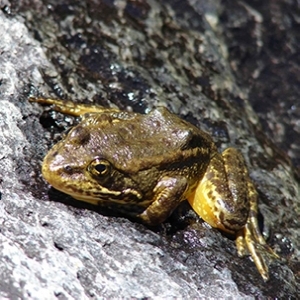MOUNTAIN YELLOW-LEGGED FROG
Rana muscosa
The mountain yellow-legged frog occurs in the San Gabriel, San Bernardino, and San Jacinto mountain ranges. They occur in various creeks and canyons within the Upper Santa Ana River planning area. They are scarce due to predation by introduced trout, habitat degradation, stream channelization and pollution.
Habitat for this species includes rocky and shaded streams with boulders or vegetation growing along the water’s edge. These frogs require perennial water flows for reproduction, larval growth and survival. Adults feed on beetles, flies, ants and other insects, as well as other amphibian species. Larvae feed on algae and diatoms located on the bottom of streams. Breeding occurs from March to August and hibernation occurs from November through February. They hibernate beneath ice covered streams, lakes and ponds.

| Life Stage/Activity Period | Jan | Feb | Mar | Apr | May | Jun | Jul | Aug | Sep | Oct | Nov | Dec |
|---|---|---|---|---|---|---|---|---|---|---|---|---|
| Hibernation | ||||||||||||
| Aestivation (in dry conditions) | ||||||||||||
| Breeding |
See a map of the modeled species habitat distribution
The decline in mountain yellow-legged frog is severe with an estimated loss of 99% of historic sites due to a variety of human related threats and impacts. Management includes reintroducing eggs and tadpoles to streams and creeks, nonnative fish removal and other habitat enhancement activities.
How you can help: Don’t collect yellow-legged frogs and tadpoles, and don’t release your unwanted bullfrogs or fish into natural areas.
